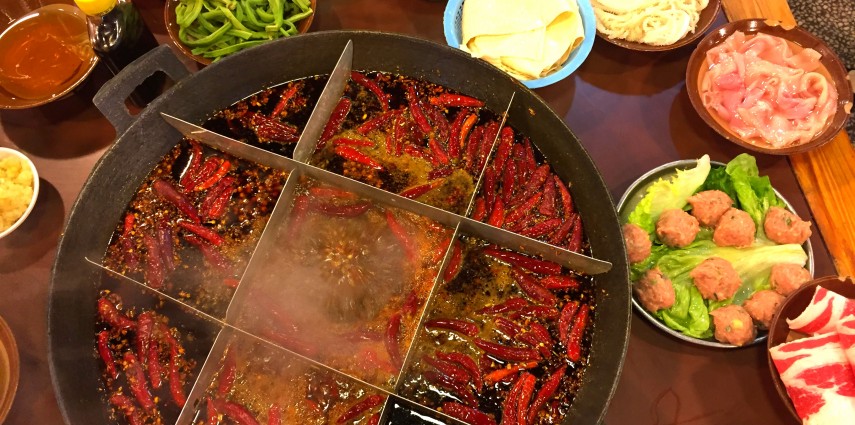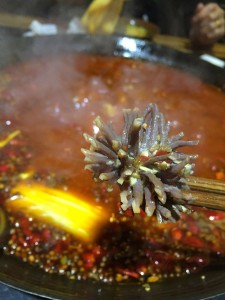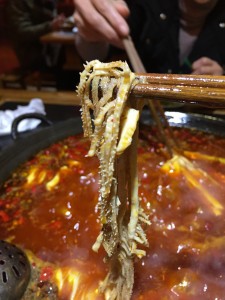Hot Pot is a must-eat for anyone visiting Chengdu and it is an essential part of eating for anyone living or staying in Chengdu. Getting what you want, however (especially for those who don’t read Chinese) can be a challenge for anyone new to the scene. We endorse adventurous eating and sometimes showing up at a busy restaurant and resigning yourself to the situation can produce the best experiences, but maybe you’ve been there, or you don’t want to take the chance – we will do our best here to help arm you with the knowledge you need to maximize your Hot Pot Experience.

Get it while its hot!
Hot Pot Primer
A Quick History of Sichuan’s Favorite Dish
A hot pot is any simmering dish in the middle of a table in which raw ingredients are cooked. The origins of the hot pot are believed to lie in Mongolia, where it was first eaten over 1000 years ago. Since then it has spread throughout China and large parts of Southeast Asia. In each region the soup base, as well as the ingredients added can vary greatly. When we talk about hot pot in Sichuan (arguably where it has become most famous) we are talking about the spicy, and numbing Chongqing Hot Pot. The base of this hot pot is usually a pork or beef stock, with spiced oil and loads of chili peppers and Sichuan peppers, while other ingredients such as star anise, cardamom pods, and Chinese 5 spice can be added. In Sichuan, hot pot is a dish and a way of life – it’s a busy, interactive, communal dinner that is as much an event as it is a meal.

A busy local hot-pot joint
1. Getting Started
Facing the mountain of choices
Upon entering a Hot Pot Restuarant you will be addressed by a waiter who will unleash a series of questions upon you to help you control your experience.
i. Choose Your Pot – pick spicy red oil (红锅), half spicy & half clear broth (鸳鸯锅)or just clear broth (白锅). We recommend at least half and half for the real Sichuan experience.

A mixed-pot, with clear broth in the middle
ii. Choose Your Oil (refers to the spicy red oil) – at some places you will be asked what kind of oil you want, namely vegetable based 菜油, or beef based 牛油. Traditional Chongqing Hot Pot’s tend to use beef based oils and some old-time purists will insist this is the only way to get the real flavor, but most places now use vegetable oils.
iii. Choose your Spice Level – Be sure not to forget this one if you are worried about handling the spice, or you want to get the sweatiest, hottest pot possible
- Extra Spicy -特辣
- Medium Spicy – 中辣
- Flavorful Spicy (the most mild option) – 味辣
iv. Prepare you Personal Dish 碟子

Fragrant oil – not a mini beverage
Add your small tin of fragrant oil to the small bowl in front of you and fill it with your choice of crushed garlic, chives, cilantro, salt, MSG, oyster sauce and vinegar, all of which should be provided on the table. Once the food is cooked properly you will take it from the ‘hot pot’ and dip it into your own dish to cut the heat and add some savory flavors before putting it into your mouth.
Some restaurants will have a buffet style display for fixing you personal dish which can include ingredients from sesame paste, to fermented black beans, crushed peanuts, and hot peppers. Experiment and try whats best for you – or go classic with oil, garlic and cilantro.
2. What to Order

How do we get to this?
The all-Chinese-character multiple-choice-test menu can be both overwhelming and underwhelming at the same time. Here’s a list of our recommended ‘go-to’ dishes and their Chinese translations. You can always get the waiter to help you order as well, or show them this list.
- fatty beef 肥牛
- shrimp dumplings 虾饺
- meat balls 肉丸子
- tofu skin 豆皮
- mushrooms 香菇
- needle mushrooms 金针菇
- bamboo shoots 笋片
- lotus root 藕片
- dried vegetable stalks 贡菜 (so crisp)
- potatoes 土豆片 (potatoes are usually added last due to their starchy nature and effect on the pot)
If you are a bit more adventurous and want to get into the world of organs/innards and local specialties we highly recommend you try these ‘accessible’ favorites, all of which taste much more delicious than they sound, and soak up the flavors of the hot pot very well.
- thousand layer cow stomach 千层度
- duck intestines 鸭肠
- chicken gizzards 肫干
- Chicken gizzard
- Delicious cow stomach
A warning – some vegetables such as cauliflower and broccoli as well as leafy greens often pack the hottest punch as they soak in more of the soup and trap hot peppers and sichuan peppers in their branches and folds. Meats, tofus, and mushrooms are in general most complimentary to the pot.
*Don’t miss SuRou 酥肉 battered, spiced and deep friend strips of fatty pork. Don’t put these into the pot, just pop ’em straight into your mouth and enjoy.
3. Drinks!
Cool the Heat

Snow the king (?) of beers!
Nothing goes better with Hot Pot than the light local beer. Enjoy the local way, by pouring into the small glasses and cheersing someone (or everyone) before each drink. This cools the heat of the pot nicely and is often an important part of building the mood of the event.
For those who don’t drink alcohol there are many other drinks that cut the heat nicely (and you can still drink out of the small glasses and join the cheersing fun).
- Herbal Tea (wanglaoji or jiaduobao) – a sweet syrupy concoction of herbs and Chinese medicine designed to expel the heat and spiciness from your body.
- Nut Milk – made from walnuts, peanuts, soy nuts or a combination these milky drinks taste delicious and soothe a fiery mouth
- Sour Plum Drink – the sour fruity flavor cuts nicely through the spice
4. Group Buying, Aprons and other Ways to Win
Group Buying – If your looking for a deal and you can navigate an interface in Chinese (or have friends who can help), seek out one of China’s group buying programs (i.e. MeiTuan or DianPing) whose deals are ubiquitous at establishments around the city. You don’t get to order your own dishes but the savings are incredible – a set for a group for 7-8 (usually suitable for 6) can be found for around usually half the price of ordering on your own, and it cuts the hassle of having to deal with the confusing ordering system.
Nothing sours a hot pot experience like ruining your clothes, and while we never recommend wearing white to hot pot, there is absolutely no shame in asking for an apron to save your clothes. Much to the same tune it’s ok to ask for help getting the food from the dishes and into the pot – which can also lead to many ‘red oil incidents’ for those less adept with chopsticks.

Apron on, ready to go
Take note that as the Hot Pot progresses your ‘diezi’ or personal dish will get increasingly spicy as some of the spicy oil gets transplanted into it. Add vinegar to cut the heat, or if its too much to bear ask for a new bowl and prepare a fresh mix.
Be patient, and make sure you cook meats properly before eating. Meatballs and shrimp dumplings will generally be ready when they float to the top. Judge by time and coloring on other meats, or again don’t be afraid to ask people your with or the waitresses for their opinion. Also it is recommended to add potatoes and other starchy ingredients last as they can change the consistency of the soup.

HOT POT PARTY!!
Hot Pot is best enjoyed with a group of 4-8 people, obviously the more attendees the more choice you have, and the more things you can order. Hot pot is an event in and of itself and can last for hours with people slowly picking at food, drinking and conversing. The meal is the party, slow down and enjoy yourself!
We feature hot-pot regularly on your Chengdu Classics tour. Let us show you the way!



